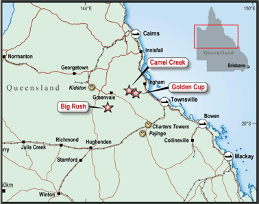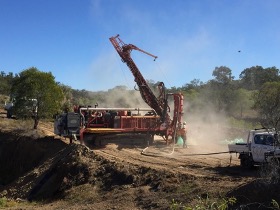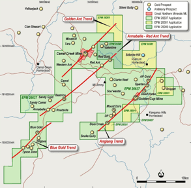Jackpot: Great Northern Minerals hits antimony bonanza with scoping study set to uncover further potential

Pic: Bloomberg Creative / Bloomberg Creative Photos via Getty Images
Things have changed at Great Northern Minerals – it’s all been about the high-grade gold inside an underexplored goldfield in North Queensland – last operated in the mid 1990s – but then Camel Creek happened.
A reverse circulation drilling program undertaken towards the end of 2021 uncovered high-grade antimony in addition to gold, leading the company to consider including the intersections in a mineral resource estimate for Camel Creek – one of three projects forming what is known as the Golden Ant Project, 200km away from Townsville.
One highlight from the drilling includes drillhole CCRC86, which intersected ‘bonanza grade mineralisation’ of up to 1m at 105.5 g/t gold and 0.6% antimony from 127 – 128m down hole, representing a compelling target for potential underground mining operations.

GNM uncovers antimony ‘holy grail’ at Camel Creek
Great Northern Minerals (ASX:GNM) CEO and MD Cameron McLean told Stockhead antimony at the Golden Ant project site was found in contained stibnite, the most common antimony mineral mined after it is recovered by flotation to produce an antimony concentrate.
“Antimony has been classified as a critical mineral in Australia, the US, and part of Europe,” Mclean said.
“We are very excited about its discovery at the project because not only has the price shot up over the last 18 months from US$6,000 per tonne to US$14,00 per tonne but it is commonly used in the electronics industry, which means it will be in strong demand for the clean energy transition.
“It is used in the manufacture of solar cells and panels, in liquid metal batteries and can be alloyed with other metals to improve their hardness and strength.
“Antimony compounds are also used to make flame retardant materials including paints and glass.”

Gold resources lift 111% to 386,000oz
The decision to include antimony in the new resource model did not disappoint.
GNM has since unveiled an initial maiden resource of 202,000oz of gold and 9,000t of antimony for the Camel Creek deposit – demonstrating an increase of 111% in contained gold resources to 386,000oz with major upside, given that 65% is contained within the Hinge Zone that remains open at depth and along strike.
Recent drilling at the Hinge Zone returned results such as 7m at 2.4 grams per tonne (g/t) gold and 0.5% antimony from a depth of 222m down-hole with GNM noting that it represents an “exceptional” underground target.
Managing director Cameron McLean said the initial Camel Creek resource of 2.4 million tonnes grading 2.6g/t gold and 0.4% antimony represented a material step forward for the Golden Ant project and will underpin its scoping study.
It has also driven a material increase in the overall Golden Ant Project to 6.1Mt at 2 g/t gold.
“Exploration activities will continue at our Golden Ant Project as we seek to further increase the mineral resource and, as part of the scoping study, seek to better understand the potential for higher grade mineral resources at depth at Camel Creek and Golden Cup,” McLean said at the time.
High-impact drilling program kicks off Q2
As part of the Golden Ant Scoping Study, targeted for completion by the middle of the year, McLean says metallurgical test work will be carried out to better understand the potential to produce an antimony concentrate from the Camel Creek deposit.
A four pronged, fully funded, high-impact work program is underway to increase the mineral resource base even further, deliver exploration success, advance the scoping study, and understand the full extent of the antimony potential.
As it stands, GNM has completed mineral resource estimates (MRE’s) for its Camel Creek, Golden Cup and Big Rush deposits but believes there is substantial potential to increase the over resource even further.
“The Golden Cup deposit is only defined to 70 metres vertical depth and further deeper drilling at depth is likely to define additional mineralisation in this area,” McLean says.
GNM is currently planning a drilling program to test the Golden Cup depth extensions which will begin in Q2.
More undrilled targets could leave to discovery
But on an even more exciting note, GNM controls the Amanda Bell Goldfields, which contains the Camel Creek and Golden Cup deposits.
Historical mining operations were undertaken at multiple satellite deposits within the goldfield (Red Gold, Mt Dora, Dora Creek, Beatrice, Blue Gold, AP Gold, Spartan and Dead Horse) which GNM control but have not yet been able to access.
McLean says there are also many undrilled targets and open-ended intersections underneath several previously mined open pits.

“Gold bearing oxide ore has been mined from open pits at these deposits and it is believed that there is the potential to define significant sulphide mineralisation (gold plus antimony) at a number of these deposits,” he said.
“EPM 26637 is expected to be granted imminently and this will allow GNM to commence work (exploration, resource estimation) on known historical mines, with priority being the Red Gold deposit.”
This article was developed in collaboration with Great Northern Minerals, a Stockhead advertiser at the time of publishing.
This article does not constitute financial product advice. You should consider obtaining independent advice before making any financial decisions.
Related Topics

UNLOCK INSIGHTS
Discover the untold stories of emerging ASX stocks.
Daily news and expert analysis, it's free to subscribe.
By proceeding, you confirm you understand that we handle personal information in accordance with our Privacy Policy.








